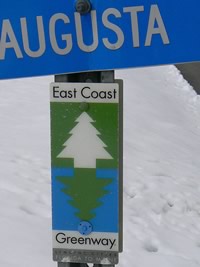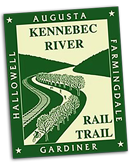 The Kennebec River has undergone substantial change over the past 250 years. It was first used by Native Americans and European settlers for water transport and fishing. Paths along the Kennebec provided the basis for land transport and in the winter sleds were used on the river ice. In the 19th century the river began to be used for commercial purposes, and in the very late 19iih century the river’s ice harvesting, known as “white gold,” provided substantial employment during the winter months.
The Kennebec River has undergone substantial change over the past 250 years. It was first used by Native Americans and European settlers for water transport and fishing. Paths along the Kennebec provided the basis for land transport and in the winter sleds were used on the river ice. In the 19th century the river began to be used for commercial purposes, and in the very late 19iih century the river’s ice harvesting, known as “white gold,” provided substantial employment during the winter months.
For many decades in the twentieth century, the Kennebec was used to serve the needs of the paper and pulp industry, which was a primary economic force for many of the communities. Due to the log drives and pollution both from the mills and untreated municipal sewage, the river’s potential for other uses was almost nonexistent. With the passage of amendments to the federal Clean Water Act in 1972, profound changes began to occur to the river. For the first time in over 200 years the water quality began to improve due to extensive public and private investment in waste water treatment facilities. In 1977, a year after the last log drive, the first Great Whatever Race was held to celebrate the opening up of the river to new uses. By 1986 the river had undergone such a transformation that the Kennebec River Council could report in almost disbelief that “there is one central and surprising problem facing all current users of the river. The Kennebec River is clean.” In response to this new “problem,” access to the river has been significantly increased with the construction of boat ramps and the building of the Kennebec River Rail Trail on the west side, and the Augusta Greenway Trail on the east side.
The regional Kennebec Trails map that has been produced as a guide to our wonderful backyard. As John Stilgoe wrote in Outside Lies Magic: Regaining History and Magic in Everyday Places : “Savor something special. Enjoy the best-kept secret around the ordinary, everyday landscape that rewards any explorer, that touches any explorer with magic.” The Kennebec is indeed a magical place and is just one of 18 rivers in Maine to have portions of it designated as “outstanding river stretches.”
The clean river, and maintaining access to this resource, are the challenges that we face in the opening decades of the 21st century. As you enjoy the river and trails of the Kennebec Valley, consider becoming an active steward in promoting the welfare of the Kennebec and the region by joining and supporting any of the organizations listed in the Kennebec Trails map.

